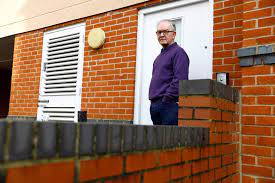In a health system in crisis, Britain’s heart care suffers.
In April 2021, Garry Cogan felt a slow, burning pain move steadily higher through his right arm. It was the start of a major heart attack that doctors warned could shave decades off his life without timely triple-bypass surgery.
Nearly two years later Cogan is still waiting for an operation from Britain’s overwhelmed health service, one of millions to suffer as it buckles under the weight of an ageing population, a lack of investment and the COVID-19 pandemic.
“It’s made me feel very uneasy in myself, very tentative about what I can and cannot do,” said the 62-year-old warehouse worker from Colchester, southeast England, who has reduced his working week to three days out of fear he could trigger another attack.
He is one of a record 7.2 million people in England waiting for treatment in Britain’s National Health Service, or NHS, built after World War Two to provide care for all, free at the point of use from the cradle to the grave.
Long a source of national pride, its decline now dominates the headlines in Britain and videos on social media show people being treated in corridors and waiting for hours on trolleys, while ambulances queue outside, unable to secure a bed in full emergency wards.
Britain’s cardiology departments are a microcosm of the problems that have spread through the system. Staff shortages and years of stagnant investment are straining wards to their limits, with life-threatening consequences for patients.
Sonya Babu-Narayan, a practicing consultant cardiologist in London, described a “cardiovascular crisis” in Britain, with excess deaths due to cardiovascular disease remaining high after the pandemic, while deaths from cancer and other conditions had begun to fall back towards average trends.
The British Heart Foundation charity says full treatment after a heart attack should begin within 18 weeks but a third of patients are currently not being seen within that time. In November, around 8,000 people like Cogan had been waiting more than a year for heart treatment, up from a couple of dozen pre-pandemic.
Since the pandemic began, the combination of COVID-19 and the resulting disruption to care has meant an average of more than 230 people have been dying a week with heart disease than would normally be expected, the charity said, and rates have remained high even as deaths from COVID infection fall.
There are signs that after-effects of the pandemic are disrupting regular care and operations.
For example, for one specific heart condition, cardiomyopathy, four times as many people are being diagnosed only when they reach a hospital compared to before the pandemic, charity Cardiomyopathy UK has found, indicating the illness is not being spotted earlier at regular check ups.
When a heart attack happens, cardiologists say a patient needs to be in an ambulance in 18 minutes. At the time of Cogan’s heart attack, the average wait time was 20 minutes. In December, the average ambulance wait time for such patients was 93 minutes, NHS data shows.
In response to a Reuters question about the excess death data and care delays, NHS England said cardiac patients were among the people waiting the longest for treatment, but that the number of patients waiting 18 months or more had fallen. In November, the number waiting 18 months was 44% lower compared to the same month in 2021, NHS data showed.
Teams were still trying to restore cardiac services to pre-pandemic levels, NHS England said.
“Covid has inevitably had an impact with fewer people coming forward for care,” a spokesperson said.
Babu-Narayan said that as a result of the pandemic, patients stayed away from hospitals and family doctors, made fewer appointments and received less preventative care as a result. Pandemic disruptions to diagnosis and treatment, in addition to delays in emergency care, had an outsized impact on cardiological care, she said.
Shortfalls in capital investment before the pandemic, when the government embarked on a nine-year-long program of fiscal austerity, meant too few beds were available, she said. A cycle of staff shortages compounded the workload of doctors and nurses, in turn driving more to leave the service.
“We’re skilled in what to do. We know how to help, but the hospital is full and there aren’t enough of us,” she said, describing the situation as personally deeply distressing.
In its defence, the government says it is pumping record investment into the health service – accounting for 40% of day-to-day government spending.
Prime Minister Rishi Sunak has made fixing NHS England one of his priorities, and has described recent wait times as unacceptable, this week outlining a two-year recovery plan for emergency care.
HEART SURGERY CALLED OFF
Admitted to Basildon hospital, 40 miles (64 km) from home, after his heart attack, Cogan was diagnosed with severe coronary disease on the left side. The doctor told him an operation to bypass three clogged arteries should add 25 years to his life and could be carried out within six months.
The operation never materialised. More vague timelines came and went before he was finally given a date for January, 2023, 21 months after the original incident. Then, with just four days to go, the hospital told him it was cancelled, citing a lack of staff and beds.
At one point, Cogan even considered trying to make himself ill, by going for a run so he could “keel over” and be operated on immediately, he said.
He now has a new date for his operation, on Feb. 9, but he remains wary and must call the hospital on the morning of the surgery to ask if a bed is available: “That’s the call you don’t really want to make.”
Cogan, waiting for his operation, said nurses or doctors – who were depicted affectionately during the opening ceremony of London’s 2012 Olympics and applauded in the streets during the pandemic – had been very good when he had seen them. But he said the service was run chaotically.
Even in his condition, he struggled to get an appointment with his local family doctor or to get his medication. On one visit to his local Colchester hospital, staff could not find a working ECG machine to read his heart’s electrical activity when he felt a twinge. The two hospitals disagreed over his priority level.
Neill Moloney, Deputy Chief Executive of the NHS Foundation Trust in charge of Colchester Hospital, said the hospital had apologised to Cogan for his experience in 2021, and had since “reviewed our procedures and made improvements.”
Mid and South Essex NHS Foundation trust, which runs Basildon hospital, said it had treated Cogan in order of clinical priority and that his surgery was scheduled for Feb. 9.
In line with the national picture, where people are turning up at hospital with more things wrong with them, or in a more serious condition, Cogan has also developed a hernia, which cannot be operated on until after his heart operation.
BEDS, STAFF AND CASH
In 2022 England and Wales recorded 45,000 deaths above the 2015-2019 average, making it the deadliest year by this metric since 1951, outside of the COVID-19 pandemic.
Some 2.5 million people are also out of work due to long term sickness, with the lowest paid most affected, the Office for National Statistics (ONS) said.
The Bank of England has cited ill-health as one reason for a reduction in the size of the workforce.
It is too soon to know what impact long COVID and large waiting lists have on the workforce, the ONS said, but the government is investigating any link between long-term sickness and people quitting work.
The health service had been struggling long before the pandemic.
Growth in spending on health accelerated under the previous government of the Labour Party, contributing to the longest period of sustained real spending growth in NHS history, the Institute for Fiscal Studies said.
And while health spending did not sharply decline when the Conservatives came into power in 2010, it plateaued, and IFS economist Ben Zaranko said Britain’s aging population put extra pressure on NHS budgets.
“The NHS was gradually deteriorating in terms of its performance even ahead of the pandemic,” he told Reuters.
According to the Organisation for Economic Co-operation and Development, health spending as a share of UK economic output averaged less than 10% in the years leading up to the pandemic, compared with rates closer to 12% in Germany, which has 60% more doctors per head than in Britain.
Between 2014 to 2019, the number of British public hospital beds fell by 7% – the sharpest decline among the Group of Seven advanced economies – and The Health Foundation, a charity, estimates the NHS needs a further 103,000 staff to meet demand.
Such is the pressure that nurses went on strike this year for the first time in their union’s 106-year history.
Analysts say that while recent additional funding could help pay staff more, it is not enough to transform the NHS, or prepare it for a future with an older population.
The Nuffield Trust think-tank has also found that the registration of doctors from the European Union slowed in the years after Britain’s 2016 Brexit decision to leave the European Union, possibly exacerbating staff shortages.
Siva Anandaciva, chief analyst at the King’s Fund, a charity that works to improve health outcomes, said the combination of structural problems and pressures from COVID means it could take a decade before the NHS hits its targets again.
“There is no short term fix here,” he told Reuters.
Email Health broadcast: contact@healthbroadcastingservice.com
Visit Website:: www.healthbroadcastingservice.com












